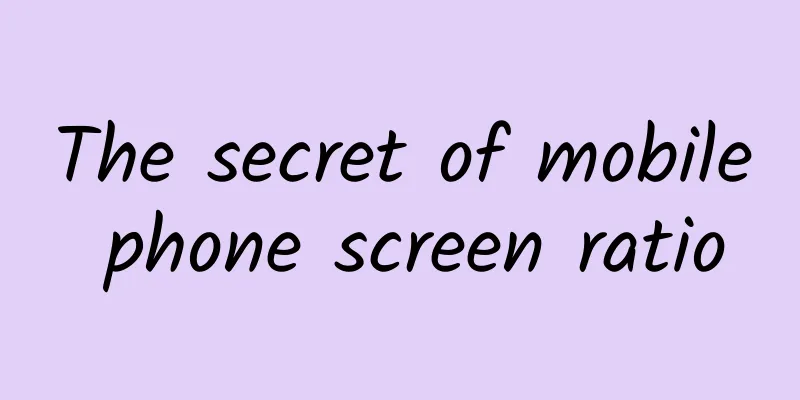The secret of mobile phone screen ratio

|
Recently, Meizu CEO Huang Zhang, or J.Wong as he is known, launched a vote on the screen ratio of products on the Meizu forum and Weibo. Will Meizu's next product choose the mainstream 16:9 or the less common 15:9? This has attracted attention from all sides, and some comments say that this is Huang Zhang's way of backing down and returning to the mainstream market. So what is the truth? Let's interpret it. The change in the ratio of mobile phone screens From black and white screens to color screens, there was no unified ratio at first, and each company made its own. But after the popularization of color screens, 4:3 gradually became the mainstream. That is the familiar QVGA, 320*240. This is because the ratio of computer screens at that time was generally 4:3, and computer screens were because the standard ratio of early movies and TV was 4:3. This ratio has almost become a standard, and the standard ratio of digital cameras and mobile phone cameras is mostly 4:3. With the popularization of DVDs, 16:9 gradually replaced 4:3 as the mainstream ratio of TVs. Computer screens experienced a period of 16:10 and also developed towards 16:9. This trend also continued to mobile phones. Before the iPhone appeared, Japanese mobile phones with leading screens already had screens of 800*480 and 854*480. The ratio of iPhone and Meizu In the era when the iPhone appeared, the processor performance was limited. In order to slide smoothly, the iPhone did not choose VGA or the higher WVGA, but chose HVGA, which is 480*320, a 3:2 odd ratio. This choice can be said to be a last resort. The first generation of Android G1 also chose 3:2 HVGA. When Meizu M8 was formulating the screen ratio, there was controversy in the forum at that time, 720*480 or 800*480? 800*480 was a mainstream resolution at the time, and there were upstream suppliers who could supply it, while 720*480 was a resolution that required a customized screen. In this regard, Huang Zhang explained at the time that there are two types of videos: 4:3 and 16:9, and the 3:2 screen combines the two situations, and the screen waste is smaller. This idea is somewhat similar to Nokia's CMOS. The sensor ratio of Nokia 808 is 13:9, in order to combine the two modes of 4:3 and 16:9 to reduce the waste of area. However, the widescreen video ratio in the display world is often not 16:9, and the movie ratio is 1.85:1 and 2.35:1. Huang Zhang's statement is untenable. Due to the problem of compatible applications, the 3:2 screen of iPhone persisted for several generations until iPhone 4S. First, the pixels were doubled to 960*640 instead of 480*320 to be compatible with old programs. Later, iPhone 5 simply added black borders and changed the screen size to the standard 16:9, returning to the mainstream. Meizu actually has no compatibility pressure. Android programs have developed from generation to generation, and the second generation is all 15:9 or 16:9. Meizu could have returned to the mainstream on M9, but Meizu insisted on its own 3:2 ratio, and only changed to the more mainstream 15:9 in MX2. The problem of mobile phone width and screen size For mobile phones, width determines the sense of control. Except for large-screen phones that can be operated with two hands, 70mm is basically the limit for holding with one hand. When the width is fixed, the longer the screen ratio, the larger the screen size. Before MX2, Meizu suffered a great loss in screen size. With the same width, competitors could achieve 4.3 inches, while Meizu could only achieve 4 inches. After MX2, the difference between 15:9 and 16:9 is not big. MX3 is more than 1mm wider than LG G2, but the screen is 0.1 inches smaller. Meizu talks about the real reason for changing the ratio. Currently, Android phones are basically 16:9 ratio. This ratio has become the mainstream, and various applications will also adapt to this ratio. If you make a non-mainstream ratio, there will be some problems with program display adaptation. In addition, the special ratio requires a customized screen, which will increase costs. In the increasingly competitive smartphone market, this practice obviously affects competitiveness. Therefore, Meizu's initial ratio choice was to follow Apple, but later it was slow to adjust. The real reason why Huang Zhang wants to return to the standard ratio now is the competitive pressure and user experience of third-party programs. As a winner of Toutiao's Qingyun Plan and Baijiahao's Bai+ Plan, the 2019 Baidu Digital Author of the Year, the Baijiahao's Most Popular Author in the Technology Field, the 2019 Sogou Technology and Culture Author, and the 2021 Baijiahao Quarterly Influential Creator, he has won many awards, including the 2013 Sohu Best Industry Media Person, the 2015 China New Media Entrepreneurship Competition Beijing Third Place, the 2015 Guangmang Experience Award, the 2015 China New Media Entrepreneurship Competition Finals Third Place, and the 2018 Baidu Dynamic Annual Powerful Celebrity. |
<<: Exploiting Bugs to Hide iOS7.1 Native Apps
>>: 219,000 units! SAIC's new energy vehicle sales hit a record high
Recommend
How important is the often overlooked title description copy under short videos?
As we all know, short video copywriting , shootin...
The "flying silk" in the filling of fake down jackets can cause illness! Experts: Five tips to identify
Nowadays, most people living in northern China ha...
It is said that people with big ears are blessed and people with long eyebrows live longer. Is this true?
Some time ago, there was a lot of discussion abou...
Taking Maoyan Movie as an example, the UCG platform operation strategy is explained in detail
Logically speaking, we should first prove that Ma...
Are you a master programmer or a novice programmer?
[[131541]] "Rookie" and "Master&qu...
New media operators must survive by relying on thinking, not skills!
Skills are the foundation of life, and thinking i...
Emergency consultation: Who sealed Shen Gongbao's throat?
The total box office of the movie "Nezha: Th...
Why are duck eggs always pickled? The reason is...
I believe many people like to eat salted duck egg...
Will Neisseria meningitidis definitely cause meningitis?
Recently, the news that two junior high school st...
6 useful functions hidden in Apple's iOS system. It would be a waste if you don't use them.
[[390997]] 01 Record screen and audio at the same...
Kobe Bryant endorses Ele.me, and it only takes five steps to pass the level!
These days, Kris Wu is the spokesperson for Honor...
Summary of Xiaohongshu’s operation and promotion methods!
Traffic exposure 1. The traffic for the note I po...
What does it mean when Tik Tok creates content that violates regulations? Introduction to the types of illegal content created on Tik Tok
If Douyin users want to achieve the effect of att...
Starting today, WeChat can transfer money to QQ
Today, Tencent has finally taken this step, that ...
The origin is: What is SEO thinking? What is the significance of this idea for website optimization?
How to define "SEO thinking" Generally ...









